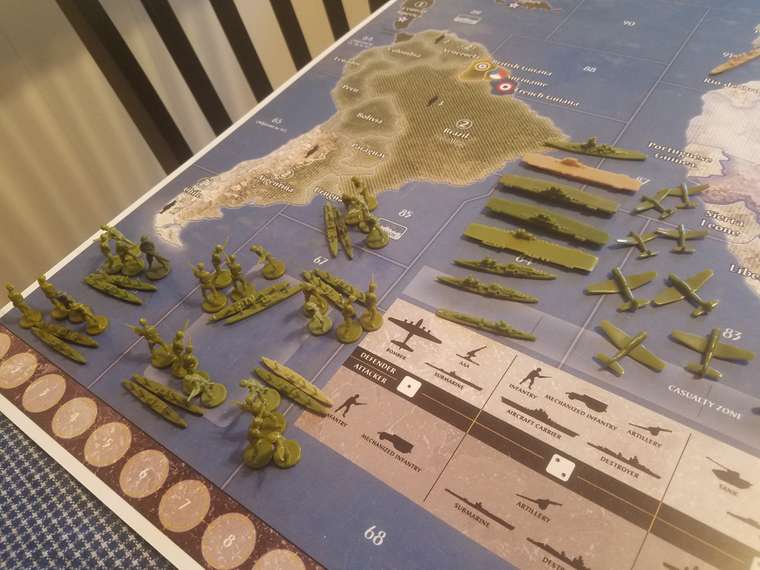Revisiting this. 1st piece
United States Playbook
We do not play chess. The sides do not start off equal, and by the end of the first turn and even into the second, the ability of the Axis to destroy units within close proximity is enormous. The Allied situation is dire from the start and gets worse. Most games played online, even with bids, end with Axis victory.
Therefore the principles that guide this Allied US strategy playbook are:
1.to preserve the Allied starting units
2. to give ground where it is hopeless or prudent
3. to determine the place of the battle when possible
The options we have are many and dependent. On the other hand they are not entirely reactionary. The strategic defensive objectives remain the same. We must save the Atlantic, Moscow, Egypt, London, India, and the Pacific. In that order in my view. The strategic offensive objectives are perhaps a little different than the Axis powers. Whereas they are going for either early London, Middle Moscow, middle or late London and an economy that is at parity with the United States at war, the Allies are going for Berlin. Thee Allies are ultimately going for a radical dashing of the economic ambitions of the Axis and a capitulation. Keeping the Germans contained on the Russian front to the gates of Moscow and no further, kicking the Italians out of Africa and keeping them out of the Middle East, containing the Japanese to a fight for China and southeast Asia and perhaps the Middle East should give the edge to the Allies.
Accomplishing the suppression of Axis ambitions is achieved in two ways
eliminate units on the board and his ability to make war.
The former is obvious, the latter may not be. Destroying an enemy’s ability to make war boils down to economics. Economics in this game is represented on the board by the cash values of the territories and the convoy zones on the map. In order to reduce your opponent’s income, you can do one of three things:
take possession of his territory, disrupt his convoys, strategically bomb his factories.
Conversely, it means not losing your own territories to the aggressors. These factors determine our strategic offensive objectives.
Destroying an enemy’s ability to make war by disrupting his convoys can be a devastating strategy. In fact in several sea zones on the map, it is catastrophic if done in numbers. Parking your navies in the Sea of Japan and in sea zone 97 to the east of Rome are prime examples of this endgame tactic. Likewise, two strategic bombers will shut down minor factories and cost the enemy double to restore them to full capacity. Five bombers will almost guarantee shutting down a major factory. Losses will be high and costly to the ally who pursues this course of action but worth it. Be aware that Germany has two major factories so he can ignore the loss of one of them. Also be aware that German itself cannot be reached from London. A point in Scandinavia or Russia must be secured or maintained in order to thoroughly execute this strategy against the Huns.
In the East, you must get very close to the Island of Japan in order to bomb her. Iwo Jima or the Soviet Far East seem the best candidates. Some have even suggested Korea. Allied planes and tactical fighters can reinforcement Korea from Hawaii if the Soviets were to capture it. A strategy that keeps Russian troops on the east coast of Russia must be used in coordination with these plans. Be careful of the kamikazes. You can non-combat move into a K-zone without triggering their wrath. An attack on a navy in Sz 6 with subs and air will not provoke Kamikazes.
Having discussed how to destroy the enemies ability to make war, we move on to how to eliminate the units on the board. How to do this with the resources on the board and the limited time before a catastrophe like the fall of Moscow occurs is the crux of the game. Historically it was agreed upon by the Allies that stopping Germany took primacy over stopping Japan. Victor Davis Hanson says that for all that kind of talk, a bifurcation developed that the West Coast produce goods for the Pacific.
 The shuck infrastructure.
The shuck infrastructure.





